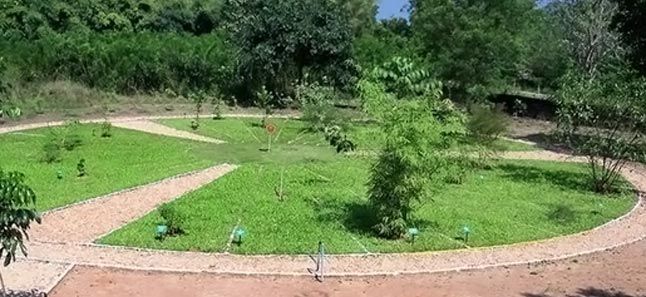Native species of plants can not only give a special look to the garden but also offer health benefits. A look by NANDHINI SUNDAR
What in essence should a landscape encompass? A manicured green expanse that serves merely as a treat for the eyes or an experience that compels one to go through, the sprawling greens offering a chance to explore, the pathways a grand trail of discovery, the plants a feast for the eyes and the body, medically and gastronomically.
The current concept of external living spaces is seeing a dramatic change in what they house, as compared to landscapes designed before, says Landscape Architect Prabhakar Rao. During a walk through six acres of herbal gardens belonging to Sri Sri College of Ayurvedic Science and Research, Dr. Rao spoke at length to Property Plus on the place of medicinal herbs in a landscape and elaborated on the techniques used.
Excerpts from the conversation.
Is the language of landscape currently witnessing a dramatic change?
Certainly. Landscape is no more viewed as a hard functional space interlaced with greenery. It is viewed more as a soft green living space that is an inspiration to explore, experience, the experience stimulating the sensory nerves where it caters to all the five senses. Sensory landscape involves plants that permit you to smell, taste, touch, and hear besides being a visual treat. The play of wind on the whistling bamboo results in different notes being heard based on wind direction and strength. Dry pods from the Indian Laburnum (Cassia fistula) produce a sound similar to a baby’s rattle, when the wind blows.
There are a whole range of herbs that delight the taste buds such as the range of mints, the Kapoor Tulsi. Some prove to be an experience too like the Spilanthes calva, a remedy for toothache. Its tiny yellow flowers make you salivate and wipes out whatever taste was earlier in the mouth, leaving a fresh feel.
This concept of sensory garden is fast catching up, replacing customary ornamental gardens that abounded in the traditional manicured landscapes bereft of our exotic native species. This new, intense interest has prompted landscape architects to introduce a diverse range of herbs into green spaces. It has also prompted a peep into our Vedic times where the palette was organised in a scientific manner, addressing both health and the senses.
Can you elaborate on the techniques of landscape as listed in the ancient Vedic text Vriksha Ayurveda?
There is a whole science behind the way a landscape needs to evolve as it has a health impact. The Nakshatravana opted during the Vedic times connects the human body to the energies emanating from the stars. The manner in which herbs are planted here, impact the mind as one walks through it. The plant palette as well as the patterns opted in the landscape impact through visual sensory appeal. The Navagraha vanam, the Ganesha vanam are good examples of this. The herbs and their scientific placement in these gardens take the attention of the mind inwards, calming the senses.
In the Nakshatra vanam, each triangle has a specific species of plant. Twenty seven such triangles prevail in the form of a yantra, with the orientation of the yantra done on a scientific basis. Each species encompasses its own specific energy and interacting with the entire space brings forth a palpable energy shift in mind and body.
Most of the contemporary landscapes house trees that are not native. Do we need to relook this?
Absolutely. The Gulmohar, Jacaranda, Tabebuia, which we find all over, were introduced merely a century back and they lack genetic diversity which makes them weak and prone to termite attack, they break easily during monsoons. They require extensive use of pesticides and this is true of all plant varieties that are not local. Besides, the pollen from alien plant varieties causes skin allergies and respiratory disorders. Likewise, contemporary manicured lawns require spraying of fungicide Phorate to remove pests, besides needing huge amount of water. Introduction of such varieties is not only unsustainable, but an ecological disaster.
It makes sense to look instead at native species such as Lemon Grass, Marigolds which have herbal remedies besides acting as natural pesticides. Indigenous species prove to be hardy and sustainable, their rich biodiversity offering an arresting palette to the landscape.
Could you suggest indigenous varieties that serve as medicinal herbs, come with culinary benefits while offering a stunning landscape?
The list is exhaustive as there is a wide range to choose from depending on what you require. For instance, Scrophularia is a perennial hardy plant, low maintenance, feeds many pollinators, is a highly priced herbal medicine for purifying the blood and serves as an excellent shrub.
The Vasa (Adhatoda vasica) is an evergreen shrub and important herb in Ayurveda. It is a fine ornamental plant with its white flowers resembling a lion’s mouth. Desmodium punctatum with its captivating flowers and used medically as stress reliever, is again a fine ornamental plant. Brahmi (Baccopa monnieri), a medicinal plant, is likewise an excellent ground cover. The Hariyalee grass, requiring zero maintenance, is another fine ground cover. The Hariyalee dhoob (Cynodon dactylon) grass is used to remove toxins from the body. Isabgol (Plantago ovata) which cures constipation is again an excellent ground cover.
Courtesy: The Hindu
